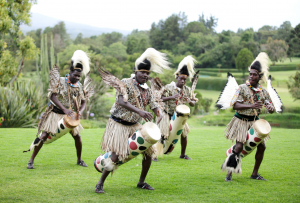Kenya is the hub of business, arts, creativity, and entertainment. In my opinion, it is also one of the most exciting countries to eat in.
The culinary culture is rich and teeming with exciting food concepts representing over 40 ethnic communities. The result is dishes that are as mixed and diverse as the country.
If you’re new in Nairobi, you’ll be looking for a guide to trying local dishes. It can be intimidating; let me take some pressure off with this Kenyan food guide.
Consider this a checklist of legendary dishes and food experiences you must try.
7 Things to Know About Kenyan Food
Kenyan cuisine is symbolic of the local people, traditions, and geography. Thanks to the over 40 tribes in Kenya, food is diverse and varies in different parts of the country.
Starch is key. The staple dish is ugali, a meal prepared by boiling maize flour in water, cooking until it becomes solid. You can have it with a variety of dishes like meat or vegetables. Wheat-based food is also typical.
Low-carb diets may be trendy worldwide, but starch is the centerpiece for most meals here.
Meat is Important. Whether it’s barbecued, grilled, fried, or braised, Kenyans love to eat meat.
Nyama Choma (barbecued meat prepared with goat meat and beef) is Kenya’s most famous dish.
Most Kenyans drink tea over coffee. Although there are many places to get excellent coffee in Nairobi, most Kenyans prefer mixed tea (tea leaves infused with spices boiled with water and milk).
You’ll find Kenyans drinking tea for breakfast, mid-morning, late afternoon, or during meetings and conferences.
Street food is popular in Kenya. You’ll find food vendors and kiosks by the road selling full meals like ugali and meat stews and snacks like boiled eggs and sausages.
Kenyans love these informal establishments because they serve generous portions at friendly prices.
Kenyans have adopted dishes from around the world. For example, iconic Indian foods such as chapati, samosa, and dhal are widely available.
Swahili food, a staple in the coastal region and very common in Nairobi, has Arabian influences.
Food is the language of love. Just like in most places in the world, food brings people together in Kenya. Anytime you visit a Kenyan household, expect to be welcomed with food. It is how Kenyans express their generosity.
It is an unspoken rule that you can’t decline food when offered. If you must, find the most polite way to say no.
Vegetarian Dishes
Farming is one of the main economic activities in Kenya, and farmers grow plenty of grains, beans, and vegetables. This contributes to a lot of vegetarian meals in Kenya.
Vegetarian meals are also more affordable; many Kenyans don’t live near fishing areas, and meat can be expensive.
Ugali
Ugali is a staple meal in Kenya. You make it with maize flour, but some people also use millet or sorghum flour. It sounds bland, and to be fair, it can be. But when you accompany it with cooked vegetables or saucy stews, it’s so much better.
You will see many people eating ugali with their hands, but you can always request cutlery if you need it.
Chapati (Flatbread)
Even though it’s originally an Indian dish, chapati is ingrained in many homes here. Kenyans make chapati with wheat flour and vegetable oil.
It’s not common, but some people add milk, so it’s best to ask about it before ordering if you are vegan.
Kenyans eat chapati with various types of stews like beans, lentils, or meat. You can have it for breakfast with your tea or coffee.
Sukuma Wiki
Sukuma wiki is collard greens made by chopping the collards and sauteeing them with tomatoes, onions, and various spices, depending on your preference.
It is a common vegetable here, and Kenyans include it in many meals.
Ugali and sukuma wiki is a full meal, but you can also pair it with any rice or chapati dish.
Githeri (Maize and Bean Stew)
Githeri consists of beans and maize stewed with onions, tomatoes, and sometimes potatoes. Traditionally, Kenyans serve it as is, but you can have it with rice or chapati on the side.
Mukimo
Mukimo is mashed green peas, potatoes, whole kernels of maize, pumpkin leaves, or spinach.
It is a traditional staple food for the Kikuyu people in Central Kenya. Still, many other communities in Kenya enjoy it too.
You can eat it on its own or have it with vegetables and stew.
Kachumbari
Kachumbari is a Kenyan salad comprising raw onions, chilies, tomatoes, cilantro, coriander, lemon juice, and salt.
Most of the time, it comes as a side dish when you order heavy meat dishes, pilau, spicy curries, and other meals.
Meat Dishes
Want to know how popular meat is in Kenya? Well, politicians and business people have brokered major deals over nyama choma (barbecued goat meat or beef)😊
Kenyans love meat; the most popular is nyama choma. But we also eat a lot of chicken and fish. There are many takes on meat dishes, and cooking styles vary; get ready to eat to enjoy plenty of flavourful meat!
Nyama Choma
Kenya is known for Nyama choma. It is barbecued goat meat or beef.
You can accompany your nyama choma with Ugali and Kachumbari or have it on its own.
Kuku Paka (Chicken in Coconut Sauce)
This dish represents many of Kenya’s culinary influences, from local to European and even Indian.
Chefs grill or sautee the chicken in butter before adding it to the coconut sauce. The sauce is a mix of coconut milk, ginger, pepper, and chilies.
You can have Kuku Paka with rice and root vegetables like sweet potatoes or chapati.
Fried Tilapia
This dish is simple and takes minutes to prepare. As the name suggests, the fish is deep or shallow fried.
Have it with ugali, vegetables, chapati, or rice.
Swahili Food
While you can find Swahili food in many regions of Kenya, it is more prevalent in the coastal area. The food has strong Asian and Arabic influences.
Compared to other meals in the country, Swahili food has a lot of spices, so you’re in for a treat if you love food with a kick to it.
Pilau
Pilau, a popular Swahili meal in Kenya, is a delicious mix of meat, rice, and spices. You will almost always find it at any Kenyan wedding.
But you don’t have to attend a wedding to have it; this meal is in most restaurants and hotels.
There are different techniques for cooking pilau, but in the end, it’s the aroma and the taste that matters. Eat it with kachumbari and vegetables like fried cabbage or spinach.
Wali wa Nazi (Coconut Rice)
Coconut rice is popularly known as wali wa nazi locally. It is a Swahili delicacy made by mixing rice and grated coconut.
You can have it with a curry of your choice, vegetables or bean or meat stews.
Kaimati
Kaimati is fried sweet dumplings coated with a sweet syrup called ‘kaimati.’
You can have it as a dessert or with tea or coffee as breakfast.
Snacks
Mandazi and Mahamri
Mandazi is a donut-like pastry that is deep-fried. It’s a breakfast favorite. Mahamri is like mandazi but made with coconut milk and cardamom.
You can eat mandazi and mahamri with a stew of beans or with tea.
Mutura
Mutura is a grilled intestine-encased mixture of minced pieces of cow or goat meat, tripe, and cooled blood.
From that description, It doesn’t sound appetizing. But it’s also flavored with onions, salt, pepper, and chili. Believe me, it tastes great.
Many refer to it as the African sausage; you can compare it with Ireland’s black pudding, France’s boudin noir, South Korea’s soondae, and Spain’s morcilla.
Viazi Karai
Viazi Karai is a street food dish that consists of deep-fried batter-covered boiled potatoes.
You can have it with a sauce made from tamarind, garlic, onions, salt, and pepper called ukwaju. It is popular in the coastal region, but you can find it in other cities as well.
Chips Mayai (French Fries Omelette)
Chips are French fries, and Mayai is eggs in Swahili, and so the meal is French Fries in Eggs.
Chips Mayai is a snack or street food you can enjoy with a side of Kachumbari and chili sauce.
Samosas
Samosas are fried pastries with a filling which is usually either beef, chicken, or green grams.
They are a popular street food snack, but you can also get them in cafes and restaurants.
Mabuyu
Mabuyu is baobab seeds sweetened with red syrup. It’s a popular candy in the Kenyan coastal regions, but you can find it in other parts of the country.
Drinks
Food isn’t the only exciting thing you can enjoy in Kenya; there are plenty of unique drinks for almost every occasion. From tea, coffee, cocktails, and mocktails, you won’t be disappointed.
Masala Tea
Tea features in most Kenyan breakfast tables at the beginning of the day, mid-day, and then again as the day ends. It is also the go-to beverage in most social gatherings.
Kenya is one of the world’s largest tea growers, so it’s no surprise that tea is so common. Masala tea is water, milk, tea masala, and loose-leaf black tea brought to a boil. Depending on your preference, you can add sugar or honey to the tea.
Dawa
Dawa means medicine in Swahili. There are two variations of the dawa drink: the cocktail and the tea.
Dawa, the Kenyan cocktail, comprises vodka, lime juice, and honey garnished with a lime wheel. It’s a delicious and refreshing drink. You’ll get it in almost any establishment that serves alcohol.
Dawa, the Kenyan tea, is a mix of lemons, ginger, and honey. It’s good for soothing a sore throat, easing a cold, or warming up. You can find it in most cafes.
Tusker Beer
Tusker Beer is a household drink for beer drinkers in Kenya. It is a known drink throughout East Africa and beyond.
The name “Tusker” refers to an elephant with large tusks, fitting since they are one of the highlights in Kenya’s famous safaris.
There’s nothing better than grabbing a cold beer in the Kenyan heat or after a long day of work.
Best Places to Try Kenyan Food in Nairobi
The Carnivore Restaurant
At the Carnivore, you can find the widest variety of meat, including goat, beef, zebra, wildebeest, and ostrich.
The meat is roasted over charcoal and carved at your table. The restaurant also serves other authentic Kenyan meals.
Nyama Mama KE
Nyama Mama KE is also a great option with a beautiful variety of Kenyan dishes.
It’s a fantastic and fun place to hang out with a great selection of drinks as well.
Tamambo Karen Blixen
Tamambo Karen Blixen is in the Karen suburbs next to the Karen Blixen museum.
They carry various Kenyan meals on their menu, and you can enjoy them in their beautiful gardens.
Mama Oliech Retaurant
Mama Oliech Restaurant is a simple restaurant in Kilimani. Still, their excellent fish, ugali, chapati, and Kenyan traditional Kenyan vegetables are far from simple.
They’re famous for their deep-fried fresh fish.
Rangers Restaurant
This restaurant is located within the Nairobi National park and specializes mainly in African dishes, so they have Kenyan food.
You’ll also have a breathtaking view of the watering hole so you can watch animals as you have your meals.
K’Osewe Ronalo Foods
This restaurant is in the middle of the CBD and fills up quickly thanks to their various authentic Kenyan meals.
In addition to Sukuma wiki, they have a variety of vegetables from different Kenyan communities.
Nyama Choma Place (Sagret Hotel Equitorial)
As the name suggests, this restaurant has plenty of nyama choma. Locals come here for tender and delicious goat ribs and legs. They serve their meat with mukimo or ugali.
It is in Milimani.
Amaica The Restaurant
Amaica has various African dishes and uses traditional cooking methods and cooking ware to give you an authentic dining experience.
The décor is also African-inspired, with sculptures and decorative calabashes all over. They are in Spring Valley.
Rosa Kempinski
The restaurant often serves Kenyan food, including githeri, ugali, nyama choma, and chapati. They are in Westlands.
Nyumbani Restuarant
Nyumbani restaurant sits in a beautiful garden in Kilimani. They are a massive draw for authentic African delicacies. Are you a fish lover? At Nyumbani, you’ll enjoy some grilled Nile perch and tilapias.
If that doesn’t float your boat, they have traditionally prepared chicken. They also serve some Kenyan favorites like chapati, ugali, and chapati.
Local Joints
Many small, informal food joints around Nairobi and other parts of the country are great to visit for authentic Kenyan meals. It’s tempting to write them off because they are small and not always the cleanest, but most serve some fantastic food.
I would advise you to go with a local or someone who knows their way around to help you navigate them and explain the menus. It’s also a great place to meet and interact with locals.
Final Thoughts
Finally, almost all restaurants carry Kenyan dishes on their menus, so it’s pretty easy to find Kenyan food if you want some. Some might have different takes on the same meals, but the food remains authentically Kenyan.
Frequently Asked Questions About Kenyan Food
What is a typical breakfast in Kenya?
Most Kenyans have tea (chai) for breakfast. It’s usually accompanied by bread, mandazi, or sweet potatoes. Families that can’t afford that go for porridge made of maize flour or millet flour.
What do Kenyans eat and drink?
The most common food in Kenya is ugali, nyama choma (barbecued meat), githeri, chapati. The typical drink is tea, and the popular alcoholic beverage is tusker beer. The choices, however, vary depending on the location and community.
What types of food are grown and eaten in Kenya?
The staple foods grown in Kenya include maize, tea, millet, and others. The crops grown depend on the region. There are over 40 ethnic communities in Kenya, and some have their native foods.
What do you eat with Ugali?
You eat Ugali with vegetable stew, meat (barbecued or stewed). Kenyans also take ugali with fresh or soured milk.
Is Kenyan food spicy?
Kenyan food varies with the region. Hot peppers and chilies are common in Kenyan food. Swahili dishes, found mainly in the coastal area, tend to be spicier.
What is Kenya’s favorite food?
The foods that most Kenyans eat are ugali, Sukuma wiki and nyama choma. Other staples also include maize, millet, sorghum, and other cereals depending on the region.







